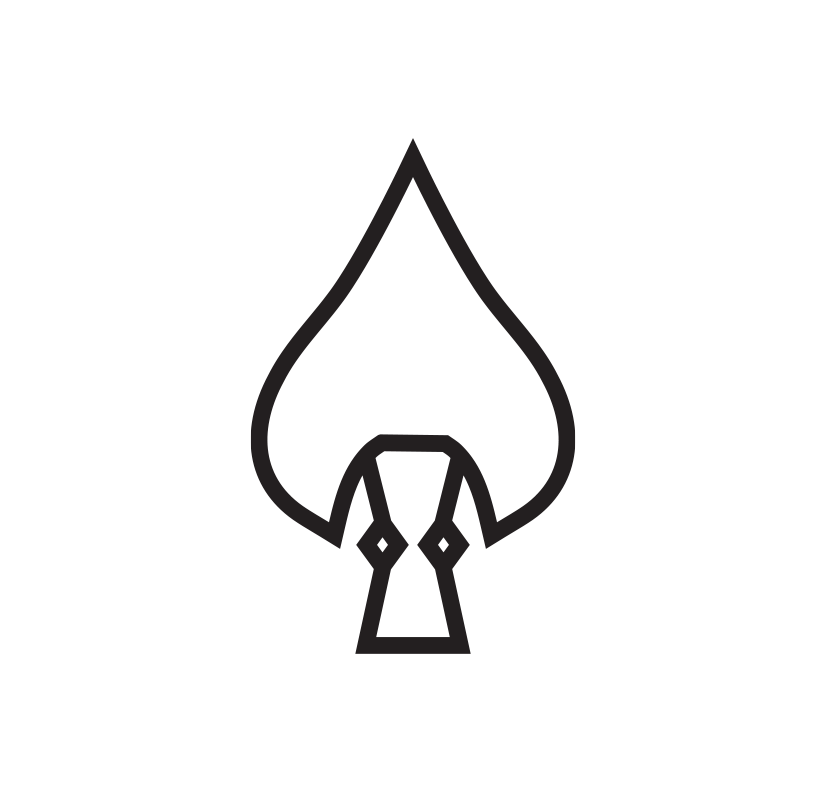Featured

Jordanian Breitling: The Gift From A King That Spawned A CIA Case Officer's Love Of Timepieces
At its core, the Breitling Aerospace is a functional tool watch. The dual digital screens of the chronometer-certified "SuperQuartz" have practical features including a digital...
Read OnAt its core, the Breitling Aerospace is a functional tool watch. The dual digital screens of the chronometer-certified "SuperQuartz" have practical features including a digital chronograph, second time zone, day and date, alarm, and countdown timer. In the intelligence business, these would be useful features for conducting clandestine operations where time matters. While serving overseas with the CIA, the second time feature would be set to Washington D.C. in order to quickly confirm when my headquarters-based counterparts would arrive in the office to check secure communications. The digital timer was particularly useful and was used to log activities during surveillance operations in African capitals, time custodial debriefings of ISIS members, and to record legs of Surveillance Detection Runs.
Read On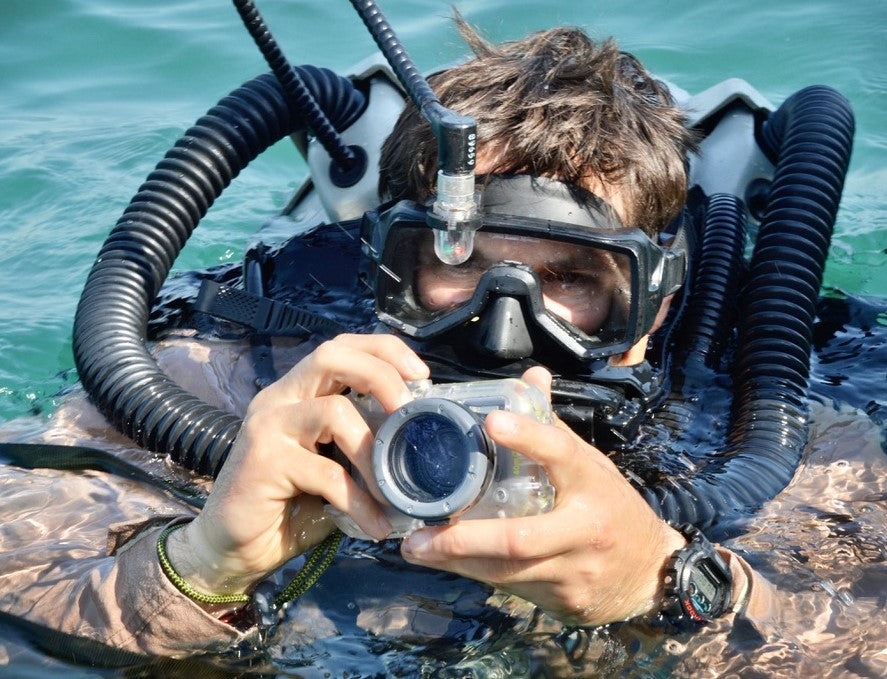
The History Of Casio G-Shocks And The US Military
Forty years have passed since the introduction of the Casio G-Shock in 1983. And while the basic formula behind the world’s most durable watch has...
Read OnForty years have passed since the introduction of the Casio G-Shock in 1983. And while the basic formula behind the world’s most durable watch has remained largely unchanged since the legendary DW-5000C first hit store shelves, the world of warfare and the United States Military in particular have made significant strides in both equipment and tactical doctrine. Conflicts in Panama, the Persian Gulf, and Bosnia/Herzegovina were waged in a bygone analog era, influenced by lessons learned in the Vietnam War. But the terrorist attacks of September 11th changed all of that, embroiling the United States in a new type of war based on counter-insurgency in the digitally-augmented age.
Read On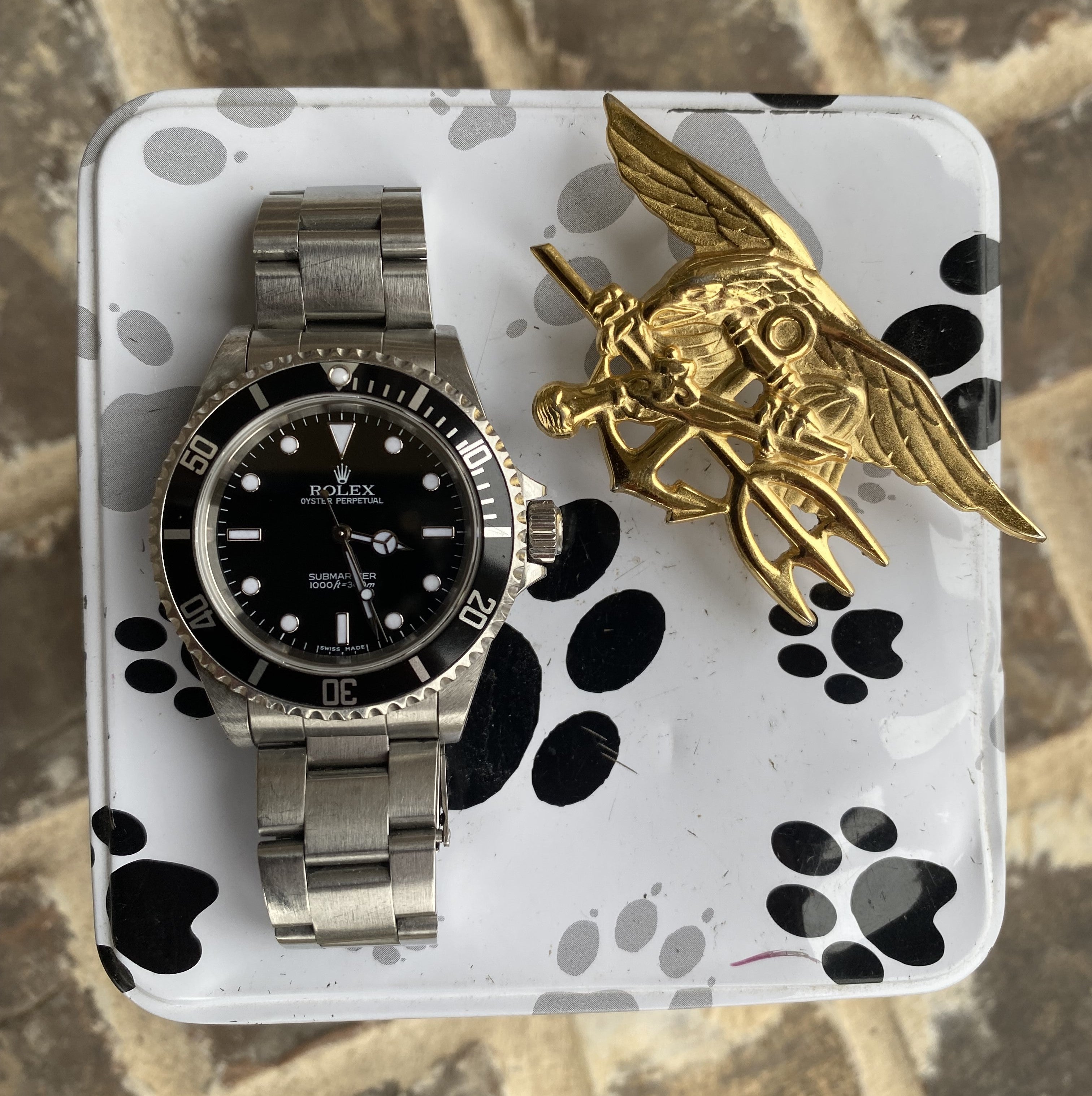
A Navy SEAL’s Rolex Submariner on the Osama Bin Laden Raid
Over the past decade, just about every detail of Operation Neptune Spear, the Navy SEAL raid that brought Usama bin Laden to justice, has been...
Read OnOver the past decade, just about every detail of Operation Neptune Spear, the Navy SEAL raid that brought Usama bin Laden to justice, has been recounted. The service members involved, the elusive stealth Black Hawk helicopters, the quad NODs, have all become objects of intrigue and some have risen to iconic status. But one detail we all missed is the Rolex Submariner on the wrist of one of the operators. This detail surprised us here at W.O.E. Why was it worn on this raid? Was it for Escape and Evasion- a potential bartering tool? Was it chosen for its robustness as a mechanical timepiece, mitigating the risk of battery failure? The answer is actually simple–but far more profound. The SEAL wearing the Sub, Will Chesney, believed he was going to die that night in Pakistan. Chesney reasoned that he might as well take his most meaningful watch with him for his final ride. He bluntly told W.O.E. that, “the watch would burn up with me.” Like many of the warriors on the helicopters that morning, Chesney thought they would either be shot down by the Pakistani air defense or blown up once inside bin Laden’s compound. He was acutely aware of the latter, as it was in part his job to mitigate that specific risk. Cairo and Chesney training at the command in Virginia Beach (Photo Credit: Chesney) Operation Neptune Spear, Abbottabad, Pakistan: In the wee hours on May 2nd, 2011 Chesney rushed out of the helicopter just outside bin Laden’s compound in Abbottabad, Pakistan. Locating bin Laden took almost ten years; ever since 2001 the US had been trying to track down his whereabouts. Finally, the time had come to strike. Chesney had two things he cherished with him: the Submariner on his wrist, but more importantly, one of the most important members of the team: a 70 lb Belgian Malinois named Cairo. Chesney humbly described his job as “babysitting” the highly trained combat assault dog, but the task was crucial. The duo screened the perimeter of the compound for Improvised Explosive Devices (IEDs) before moving inside with the team to sweep the compound for explosives or hidden rooms. Like the men on the mission, Cairo was a seasoned operator with multiple combat deployments. In fact, the dog was shot twice during an operation in Afghanistan less than two years prior. Media would quickly report on the presence of Cairo, including sensational claims that the dog had titanium teeth, one of the many inconsistencies that would lead Chesney to write a book, No Ordinary Dog, in an effort to document the history and honor the legacy of his best friend. Red Squadron “Red Man” patch on Cairo’s vest, the same emblem engraved by the SEAL armorers on the Rolex Submariner's caseback. The Rolex Submariner: Like Cairo, the Submariner was no ordinary Rolex. It was a late 2000s no-date reference 14060, the last classic Submariner with the traditional aluminum bezel insert and drilled lugs. During a 2009 visit to the Command’s armorer, Chesney laser engraved the caseback with the “Red Man'' insignia of the famed Red Squadron, the same patch on Cairo’s harness. Chesney acquired the Rolex as a present to himself when he passed screening for Naval Special Warfare Development Group (DEVGRU) in 2008. Chesney was aware of the history between Rolex and the SEAL Teams, but was ultimately drawn to the brand for what Rolex represented; it was a reliable and “cool” piece. Chesney grew up in a trailer park in Southeast Texas where, like most places around the world, Rolex stood out as a particular luxury. The Rolex Submariner reference 14060, Chesney’s Trident and a metal tin containing the ashes of Cairo. (Photo Credit: Chesney) Rolex- The Symbol of Achievement: For decades, men have memorialized professional accomplishments with the purchase of a Rolex, be it a promotion, the closing of a big deal, or retirement. Chesney was no different. Only this “professional accomplishment” that Chesney achieved in 2008 was passing “selection” and being accepted into SEAL Team Six. Chesney was one of the youngest SEALs to make it through the 50-60% attrition rate. The “Training Team” screens for the “best of the best” SEALs and like the others trying out for the Command, Chesney had multiple prior combat deployments with SEAL Team 4. Chesney and Cairo on a helicopter in Afghanistan. (Photo Credit: Chesney) After Chesney completed the selection, he visited a Rolex Authorized Dealer in Virginia Beach and quickly settled on the no-date Submariner, purchasing it new and walking out with it that same day. In contrast to those we have previously profiled, the Submariner was not a daily wear and with the exception of the bin Laden raid, he did not wear it operationally. Chesney reserved the timepiece for special occasions, which included traveling to and from every deployment. He would wear it on the plane, but once he arrived in Afghanistan, he would replace the Submariner with a digital Suunto or Garmin, a far more practical tool for a 21st century assaulter. When it was time to go home, the Rolex would come out of his bag and back on his wrist. It was a ritual and a reminder of his accomplishments. Chesney with Cairo after being shot in Afghanistan during the search for Bowe Bergdahl in June 2009. (Photo Credit: Chesney) Captain Phillips Rescue, Indian Ocean: Reflecting on his career and the role the watch played, Chesney said he had two regrets. He wished he had purchased a date Submariner, as this would have been more practical, and he wished he had worn the watch on the rescue of Captain Phillips, another historic hostage rescue operation of the famed squadron. At the time, the clasp was loose and Chesney was concerned that if he had jumped out of the plane, the watch could have come off and fallen into the Indian Ocean. As a practical man, he reflected that he easily could and should have taped the watch to his wrist. Abbottabad Compound, Pakistan (Photo Credit: AP) Usama bin Laden: Prior to leaving for Afghanistan to take part in Operation Neptune Spear, Chesney made the conscious decision to wear the Rolex for this historic mission. He knew the polished steel watch wasn’t “tactical,” but he didn’t care. He was going to die anyway, he reasoned. Like the other members of the team, he extended his life insurance policy to prepare for this eventuality. During a recent conversation, Chesney reflected, “I thought it would be fitting to wear the watch on that operation since it was my gift to myself for making it there, and I figured we wouldn’t be making it back so I might as well die with it on.” Chesney briefly considered that the watch could be used as a bartering tool if he was stuck across the border in Pakistan, but was quick to say that he would never give the watch up, implying that he would die fighting. The role the watch played was more symbolic than practical. Rolex and Navy SEALs: The symbolism of the Rolex Submariner on one of the most historic Special Operations missions is profound. Watch culture is strong in the Naval Special Warfare community and Chesney’s Navy SEAL predecessors wore similar watches– both Rolex and Tudor Submariners as they operated in Vietnam 40 years prior. The founder of SEAL Team Six, Dick Marcinko, wore a no-date Tudor Submariner, not dissimilar to the Rolex worn by Chesney that night. Many SEALs commemorated their graduation from BUD/S or other operational accomplishments with a Rolex Sub. Rolex and SEAL Trident next to Cairo’s ashes. (Photo Credit: Chesney) Fortunately, Chesney’s ill-fated premonition did not become reality. Chesney and the team successfully brought the world's most wanted man to justice and returned safely to Bagram Airbase. Days later, Chesney would wear the Submariner to meet President Obama and Vice President Biden, both of whom were insistent they get a picture with Cairo, the only member of the Team whose name had been released at the time. Chesney and Cairo meeting President Obama and Vice President Biden after Operation Neptune Spear. (Photo Credit: Chesney) But for Chesney, the fight was far from over. Chesney would redeploy and ultimately earn a Purple Heart from a 2013 grenade attack in Afghanistan. Chesney details his personal struggle with traumatic brain injury and post-traumatic stress, and credits his relationship with Cairo as a key tool in supporting his recovery. After Cairo was retired, the Navy allowed Chesney to adopt him. Cairo passed away after a battle with cancer in 2015, and Chesney was by his side. Today, the Submariner is still reserved for special occasions. The watch is in need of service, but Chesney is concerned that the Red Man insignia will be removed from the caseback. Chesney would like to potentially add to the caseback, subtly honoring friends lost during the past two decades of conflict. The piece itself will remain an heirloom: the watch will be passed down to future generations as a way to continue to honor what his team –and Cairo– accomplished that night in Abbottabad. Rolex and SEAL Trident next to Cairo’s ashes. (Photo Credit: Chesney) Chesney’s book, No Ordinary Dog, is a powerful read that explores the genuine emotional bond between a warrior and his military working dog. As Chesney summarizes, “Cairo was my dog. And I was his dad. I don’t use that term euphemistically. The relationship between a handler and a canine SEAL is profound and intimate. It goes well beyond friendship and the usual ties that bind man to dog.” The book also explores both Chesney’s and Cairo’s difficulties transitioning from years of sustained combat. In addition to the book, Chesney supports several nonprofits for both veterans and Military Working Dogs, and he specifically highlighted Warrior Health Foundation, Spike’s K-9 Fund as a particularly impactful organization. -- If you enjoyed this article, please consider signing up for our weekly free newsletter for further updates HERE. READ NEXT: SEAL Team Six And A U.S. Navy-Issued Seiko Turtle
Read On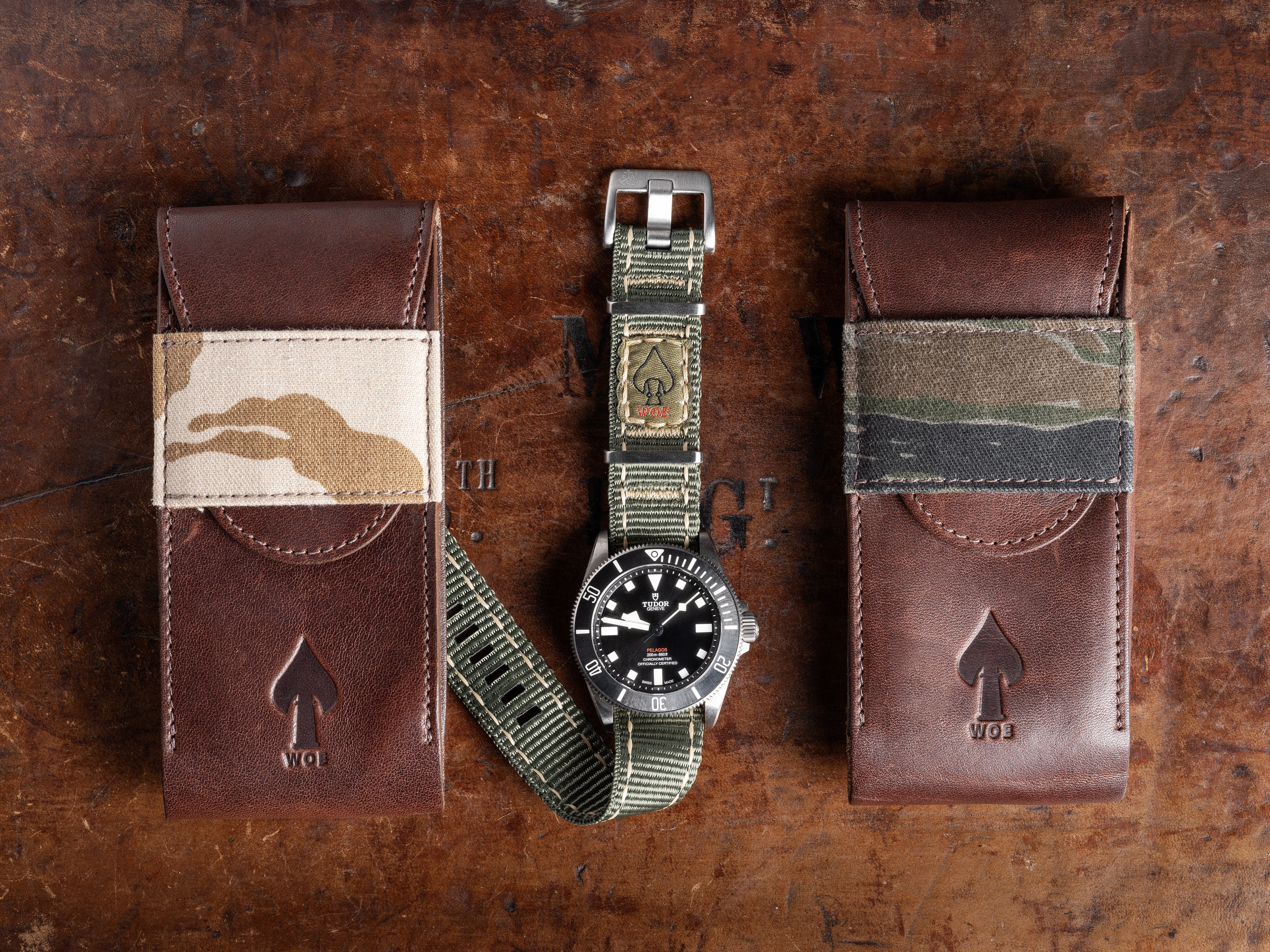
Watch Travel Pouch and Challenge Coin - The History
During a 2022 trip to Africa, I brought my Tudor Black Bay 58 and a CWC SBS. While the watch pair worked well, I realized I...
Read OnDuring a 2022 trip to Africa, I brought my Tudor Black Bay 58 and a CWC SBS. While the watch pair worked well, I realized I needed a better watch case, as the watch roll I brought was bulky, poorly-constructed and lacking character. After returning, W.O.E. worked with Leather Works Minnesota to design a purpose-built, made-in-the-U.S.A. travel case.
Read On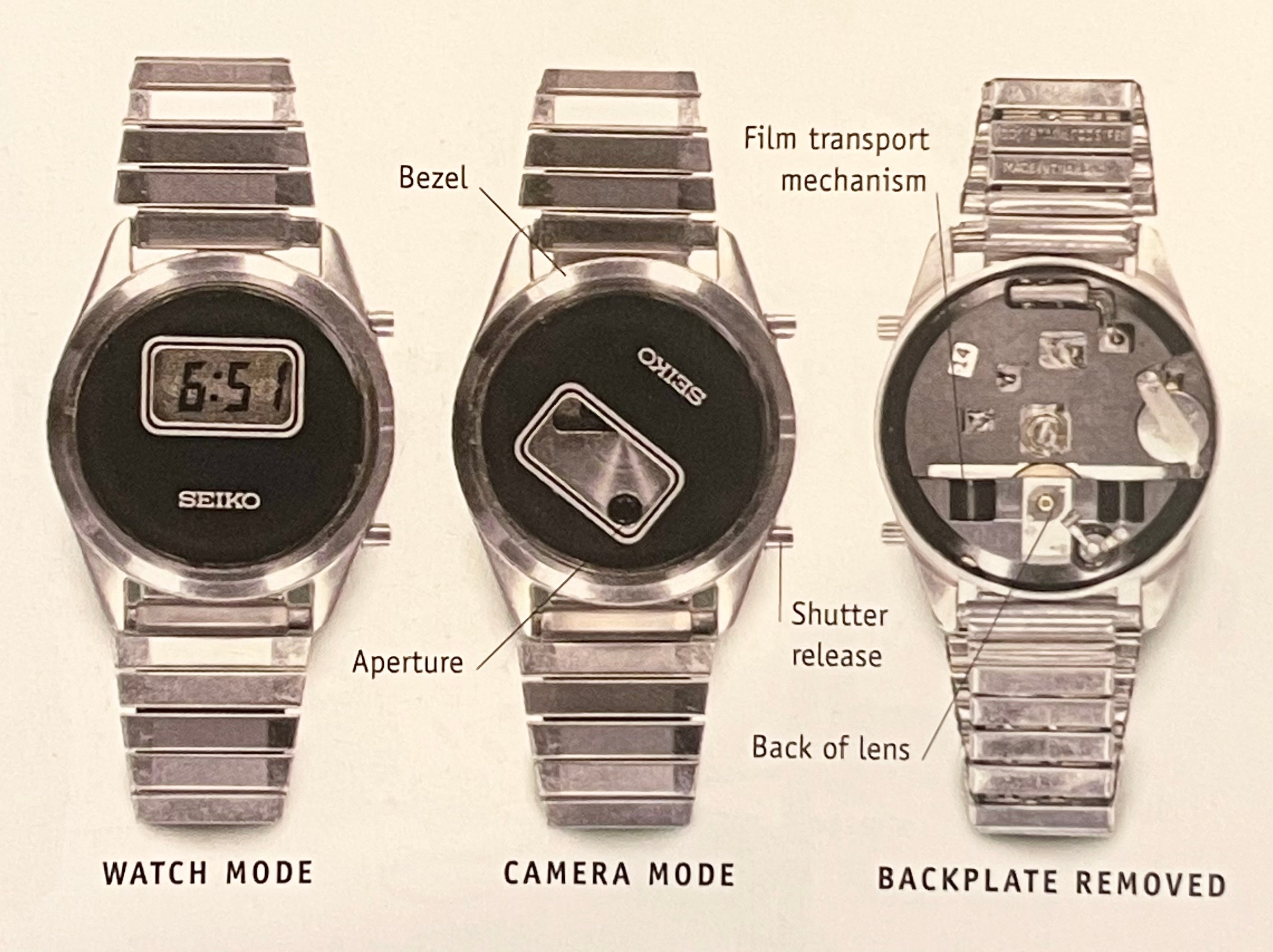
Forget Bond, A Real CIA Spy Seiko Watch
In the 1970s, CIA Technical Officers modified a digital Seiko to conceal a Tropel T-100 camera inside. The purpose of the watch-turned-espionage-tool was to allow...
Read OnIn the 1970s, CIA Technical Officers modified a digital Seiko to conceal a Tropel T-100 camera inside. The purpose of the watch-turned-espionage-tool was to allow a recruited agent to surreptitiously photograph classified documents in their place of work and deliver them to CIA. The camera was so quiet that it could be used to photograph documents within a KGB Rezidentura or other sensitive buildings while unknowing co-workers were just feet away. The Silver Screen vs Reality: Hollywood's depiction of spy gadgets embedded in a Rolex Submariner or Omega Seamaster is entertaining, but largely a fantasy of the screenwriter's imagination. In fact, there were very few times in my career as a CIA Case Officer that I used “spy gear” and instead largely relied on low-tech tradecraft to build relationships, recruit spies, and steal secrets. US Embassy Moscow- Cold War That said, technology plays a significant role in the espionage trade from both an offensive (collection) and defensive (counterintelligence) standpoint in the modern era. Historically, spy gadgetry was a crucial tool in the “great game” of the Cold War where both the Soviet Union’s KGB and CIA leveraged cutting edge technologies– including miniature cameras and audio recording devices– to collect intelligence and thwart hostile surveillance. In order to mask these capabilities, pieces of surveillance technology were often housed in “Concealment Devices,” seemingly benign objects that could be carried by the Agent into sensitive government facilities. In some now-declassified cases, a timepiece was used as either a passive or active concealment device to hide the presence of the espionage tool. U.S. Representative to the United Nations Henry Cabot Lodge Jr. points to a hole for a concealed listening device in the U.S. Great Seal (a gift from the Soviets to the UNSC). (Photo Credit: Getty) In the niche genre of Watches of Espionage, it is important to understand these historical references. We will periodically profile some of these watches, their relevance, and the impact they had on intelligence collection. The Real Q-Branch: In most spy movies, there is a “Q:” a fictional character responsible for providing the lead “spy” with the latest and greatest technological advancements. In obvious foreshadowing, the issued gear (often a luxury timepiece with spy gear embedded) will later play a significant role in the movie during a pivotal scene where the spy escapes a deadly situation or finally gets even with the villain. While I never met an individual “Q” at CIA, there are several offices dedicated to developing, testing, and fielding technologies for intelligence collection. During the Cold War, this office was known as the Office of Technical Service (OTS) positioned within the Directorate of Science & Technology (DS&T). Modified Seiko Housing T-100 Camera: In the mid-1970s OTS technical officers reportedly modified an off-the-shelf Seiko LCD-equipped model (reference unknown) to conceal a Tropel T-100 camera inside. The watch worked by “active concealment,” meaning it functioned normally when the camera lens was not visible. When the asset–or a recruited agent–rotated the dial nearly 180 degrees it exposed the aperture at the 6 o'clock position. A button at the 4 o'clock position activated the shutter to take the picture. (Photo Credit: Ultimate Spy, Keith Melton) According to intelligence historian Keith Melton, the camera held a 15-inch strip of auto-advancing film and could capture 100 high resolution images. The purpose of the tool was to allow an asset or agent to surreptitiously photograph classified documents in their place of work. The camera did not require an auto-focus mechanism and could effectively take pictures of standard-sized documents when held approximately 11 inches off the desk, which was about the length of an average adult male's elbow to hand. The camera was so quiet that it could be used to photograph documents within a KGB Rezidentura or other sensitive buildings while unknowing co-workers were just feet away. OTS produced instructions showing an Asset how to use the T-100 key fob model. Instructions also showed agents “how to hide the camera in a fist held to the forehead while seated–as if they were reading, not photographing.” (Photo Credit: Ultimate Spy, Keith Melton) While the watch concealment is interesting in itself, the T-100 subminiature camera was the real technological feat at work. Despite its size, it was designed to take distortion-free images the size of a single page of text using retired stock film first used in spy satellites. In contrast to the movies, where a piece of gear was issued “just in case,” the tiny camera was purpose-built for intelligence collection and issued only to the most sensitive CIA assets operating behind the Iron Curtain. The tool was designed and produced by an outside contractor who painstakingly assembled the shutter components and lenses the size of a pinhead. As Robert Wallace and Melton would later recall in Spycraft, the Secret History of the CIA’s Spytechs, “the T-100’s assembly was closer to watchmaking than any commercial manufacturing process. The owner of the company fabricated each camera himself under a large magnifying glass and halo light using a device he built specifically for the task.” T-100 concealed in cricket lighter (Photo Credit: Ultimate Spy, Keith Melton) Looking at the watch, it’s tempting to conclude that it looked semi-futuristic for the 1970s and that this might cause counterintelligence concerns for an asset back then. But the Seiko was created, or modified, during an important time in horology history: the Quartz Crisis. During the Digital Revolution of the late 1960s, the development of the quartz watch resulted in a transition in the market from mechanical watches to quartz movements and eventually, digital displays with the Pulsar in 1972. This quick shift was dubbed the “quartz crisis,” where many consumers moved to the cheaper more accurate timepieces and there was a dramatic decline in the traditional, mechanically-driven Swiss watch industry. Seiko, credited with developing the first quartz movement, was one of the first brands to embrace the new technology and produced several LCD screen watches similar to the one used by CIA. While we have not identified this exact reference, there are several Seiko watches from the era that match the similar design, including this 1975 Seiko 0114-0010 Quartz LC. The exact reference likely would have been procured in the Soviet Union before being shipped back to the U.S. for modification, so as not to raise questions why a Soviet official would be wearing an imported watch. Again, details matter. 1975 Seiko 0114-0010 Quartz LC (Photo Credit: Ebay) Interestingly, it was in this time period (in 1977) that the Bond franchise integrated the first Seiko into the mix in The Spy Who Loved Me. Bond, played by Roger Moore, wore a modified Seiko 0674 LC, which contained a miniature printer to receive messages from his headquarters in the UK. CIA has been known to take inspiration from Hollywood, and whether this was life imitating art or the other way around, we can only speculate. What is uncertain is whether the CIA-modified Seiko was actually used by an asset during the Cold War or if this was a prototype that never made it to the field. While much of the information from this time period has been declassified or leaked, there is no public information available indicating it was issued to an asset for operational use. What we do know is that the camera itself, the T-100, was particularly effective at collecting intelligence and was dubbed by some as the "camera that won the Cold War." There are documented examples of both the T-100 and later the T-50 being issued to assets housed in fountain pens, keychains and lighters and capturing images that were later passed on to the CIA handling Case Officer. Tropel Camera Housed in Fountain Pen, Image courtesy of International Spy Museum. READ NEXT: The Lasting Legacy Of The CIA’s Lockheed A-12 And The Watch That Served It This Dispatch has been reviewed by the CIA’s Prepublication Classification Review Board to prevent the disclosure of classified information.
Read On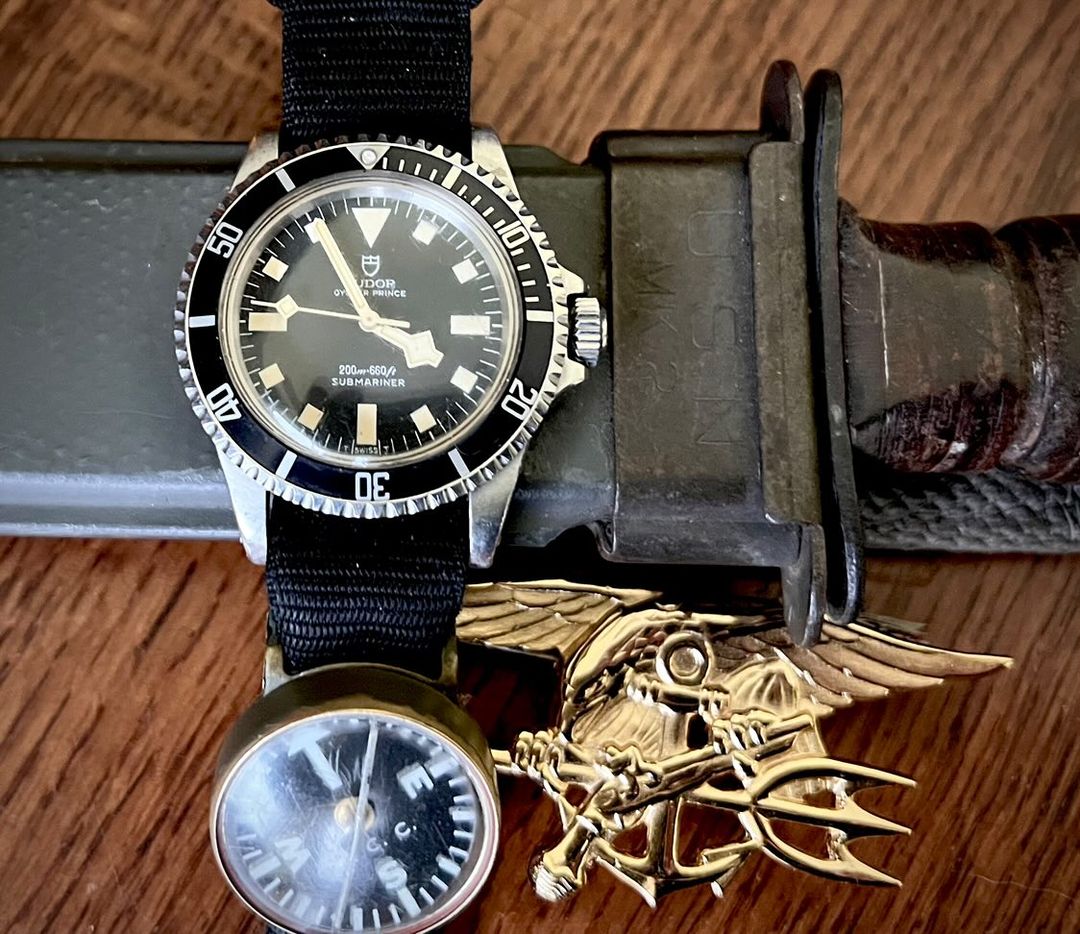
The Pragmatic Journey of a SEAL Through Watch Collecting
By Benjamin Lowry One thousand yards of open ocean undulated gently between US Navy SEAL David Hall and the dim lights of the Haitian shoreline....
Read OnBy Benjamin Lowry One thousand yards of open ocean undulated gently between US Navy SEAL David Hall and the dim lights of the Haitian shoreline. Wearing little more than woodland cammies, a Boonie hat, and a modified hunting life jacket, Hall glanced at the luminescent display of his Luminox watch and slipped quietly into the temperate waters of the Caribbean Sea. While warm, the water was acrid, stinking of ammonia and decomposition. As he began finning, open fires burned suspiciously on the proposed invasion beaches, their faint glimmer visible in the eyes of the two other SEALs finning away to Hall’s right and left. Hall and swim buddy, just before the Haiti operation. A fortuitous low-lying fog hung over the water at the insertion point, making their approach virtually undetectable. After a military coup in 1991 ousted Haiti’s first democratically-elected president, Jean-Bertrand Aristide, a Clinton-led United States initiated Operation Uphold Democracy in 1994, a military and diplomatic intervention intended to restore order and democracy to the embattled island nation. Hall’s US Navy SEAL Team EIGHT was tasked with conducting detailed reconnaissance of several Haitian beachheads to ensure the safe landing of an impending US Marine Corps invading force. Approximately 200 yards in, Hall’s swim buddy became entangled on a submerged fishing net that was being pulled in by an unseen dugout canoe. Hall closed in to assist his struggling swim buddy, miraculously freeing him while remaining unseen by the two Haitians in the boat. Once freed, Hall and two other SEALs swam to chest-deep water before being surrounded by several dugouts manned by Haitian civilians tasked with locating and reporting exactly this type of activity. In the kind of pitch blackness only offered by the sea on a moonless foggy night, one of the enemy dugouts drifted close enough to sense the presence of Hall’s three-man element. Thanks to four years of high school French, Hall understood well enough when one of the fishermen whispered, “Homme, qu’est-ce que tu fais dans l’eau?” (“Man, what are you doing in the water?”) in a lazy blend of French and Creole. Hearing the selector switches of his teammates' silenced MP5s click from “safe” to “fire” and feeling their backs move against his own, Hall remembered their orders. Anyone who discovered the SEALs or otherwise endangered the mission was to be killed as quietly as possible. After a painfully-long pause from both parties, the civilian fishermen thought better of the engagement and silently paddled into the night without another word, the rapidly beating hearts of the SEALs still in their throats. It turns out Luminox Original Navy SEAL watches were actually worn by SEALs. With around six years in the Teams, Hall had already deployed to the Mediterranean as well as the Persian Gulf for Operation Desert Shield, but the brief Haitian conflict, and this near miss on a moonless Haitian beach, presented his first up-close taste of war. Throughout his initial SEAL training and qualification as well as thousands of training hours at SEAL Teams TWO and EIGHT, Hall crafted a visceral understanding of the relationship between mission success and having the right tool for the job. Watches were then and are now yet another essential tool, as important to the mission in many cases as an operator’s weapons. But for Hall, who quickly asked me to call him Dave when we met via Zoom, watches represent a lot more than that. I met Dave (@davehall1911) through my Instagram account, @SubmersibleWrist, when he reached out to share a few photos of his time in the Teams. Afghanistan 2005, Casio Pathfinder on the wrist When W.O.E. asked me to write something for the Dispatch, I immediately thought of Dave. As one of the world’s least tactical people, I would never compare my resume to Dave’s, but my experiences as a search and rescue team leader in the US Coast Guard as well as my time as a commercial diver mean we share an intimate understanding of tool watches in the maritime environment. Setting aside his decorated 20-year career in Naval Special Warfare for a moment, Dave is a dyed-in-the-wool watch enthusiast just like the rest of us. The first “real” watch Dave remembers acquiring was a Citizen Aqualand C023 he purchased with carefully-pinched pennies from a summer lifeguarding job in northern Illinois. Looking back, the humble depth-gauge-enabled Citizen stands as the first installment in a tale of service, adventure, and armed conflict, punctuated by some of history's most iconic watches. BUD/S And An Improbable Tudor “Snowflake” Submariner, Ref 9401 Hall’s Tudor “Snowflake” Submariner, Ref 9401, SEAL Trident, USN Mk II Kabar At BUD/S or Basic Underwater Demolition/SEAL training in 1987, Dave quickly made friends with a San Diego local and classmate. Dave’s friend, who would eventually serve as his dive buddy in what was then Third Phase, showed Dave around the area and also introduced him to his uncle, a dealer of military surplus. As graduation from one of the military’s most elite training programs loomed, Dave’s buddy’s uncle mentioned his recent purchase of 100 of the last of the West Coast Teams' issued Tudor Submariners in an unmarked cardboard box from a US Navy Defense Reutilization Marketing Office (DRMO) surplus auction. Thirty-three years later, Dave clearly remembers paying his friend’s uncle $300, no small sum for a junior enlisted sailor in 1988, for two of the well-worn Tudor Submariners, keeping one and gifting the other to a family member. BUD/S Graduation 1988, Tudor Submariner on the wrist. Dave remembered seeing similar watches often worn with a brass W.C.C. survival compass on simple nylon straps on the wrists of legendary SEALs around BUD/S. One such operator who left an impression was RJ Thomas, a Vietnam SEAL who famously repelled two hundred VC fighters from his downed helicopter with an M1911 pistol, racking up 37 confirmed kills between 3 and a staggering 150 yards and injuring countless others. Hall's Tudor Submariner along with a few other relics from the Vietnam Era. For a young Dave Hall, his “Snowflake” Submariner could not have been any cooler and synonymous with the legendary operators the fledgling frogman hoped to emulate. Dave wore the Tudor for his graduation from BUD/S and throughout his career for lighter duty and the types of ceremonies and events that call for a dress uniform. All these years later, Dave still has the watch and wears it alongside a brass W.C.C. compass on a simple nylon strap, just as God and the SEAL Teams intended. Seiko Automatic Dive Watches, Stacks Of Casio G-Shocks, Pathfinders, & A Luminox Hall graduating SEAL Sniper School with a handshake from legendary Marine Scout Sniper, Carlos Hathcock. Seiko on the wrist. With the Rolex and Tudor Submariners of old all but phased out and either retained by crafty SEALs like Dave or sold at DRMO auctions, the SEAL Teams of the 80s and 90s issued a mix of Seiko automatic dive watches including the 6309 and later the 7002 as well as several generations of the venerable Casio G-Shock and Pathfinder. Dave remembers all of these utilitarian watches fondly, though he makes note of the sheer volume of G-Shock watches he went through in his career, often wearing one on his attack board and another on the wrist during combat dives. When the battery died or something failed, he simply tossed it and grabbed another from his unit’s supply officer. Hall dive training in 1991 in Scotland. Citizen Aqualand on the wrist. Along with the Citizen Aqualand of his youth, which he often wore operationally, Dave favored the utilitarian automatic Seiko divers of the era. Dave reached for his Seikos in situations that did not require the perfect stopwatch timing and self-illuminating capabilities offered by digital watches, opting for the legendary Japanese brand on the range, when parachuting, or for other land-based training evolutions. Chesapeake, VA, Range training, 1995. Seiko on the wrist. For the nerds in the room, which I assume is all of you, Dave mentioned that the strap of the 90s East Coast SEAL Teams was a simple velcro model with a depth-compensating spring-loaded buckle that once accompanied a Tekna diving wrist compass. Despite the legendary status of Seiko and G-Shock within the Teams, when Dave made the aforementioned big swim into Haiti in ‘94, he was wearing the then-brand-new Luminox Original Navy SEAL he had privately purchased. And while enthusiasts may snicker at the often-corny Luminox Navy SEAL marketing, Dave remembers enjoying the brightness of the tritium illumination on that particular mission while admitting the watch was more fragile compared to the Seiko, Citizen & Casio models upon which he normally relied. The OMEGA Seamaster Chronograph 2598.80 Hall's OMEGA Seamaster Chronograph. In 1996, Dave purchased his first luxury watch, an OMEGA Seamaster Chronograph reference 2598.80, in celebration of the birth of his first child. When asked, Dave indicates it was this very watch that he wore the most operationally, with hundreds of jumps, combat dives, and real-world combat missions and gun fights to its name. The Seamaster Chronograph of the era paired the iconic design language established by the Pierce Brosnan Bond Seamaster with its distinctive wave-engraved dial and added chronograph functionality by way of the robust but thick Valjoux 7750. Intriguingly, the watch made the first of two appearances by Dave’s watches in popular media, starring in the final scene of an episode of Navy SEALs: In Harms Way, a documentary series produced by Gordon Forbes for the Discovery Channel. And while Dave lists the OMEGA, now most often worn by his wife Tracey, as the number one operator watch of his career overall, the evolution of combat following the 9/11 terrorist attacks would call for new tactics and equipment, including a GPS-enabled Suunto Dave wore on a day of intense combat that would change his life. Freefall training in Spain, 1997. Omega Seamaster Chronograph on the wrist. An Early Suunto GPS Watch & A Very Long Day In Baghdad In 2004, with the Global War On Terror (GWOT) in full effect, Dave was stationed at SEAL Delivery Vehicle Team TWO (SDVT-2). Envisioned in the Second World War, the modern SDV is a miniature wet submersible capable of deploying from ships or submarines and carrying small teams of US Navy SEALs far greater distances than even a Navy SEAL can swim. For a particular SDV mission upon which Dave opts not to elaborate, he and a few other SEALs were issued an early watersports-themed Suunto watch offering rudimentary but useful GPS functionality at the cost of needing regular recharging. Given the growing intensity of combat operations in Iraq’s major cities, experienced SEALs from SDVT-2 and elsewhere were often sent to augment other SEAL Teams deployed in the Middle East. Transitioning from 10 to 15-hour dives in shark-infested water to the heat, chaos, and urban combat of Baghdad’s streets is no small task but is the kind of thing a senior operator like Dave was accustomed to after 15 years in the Teams. On one particular mission, Dave and three other SEAL snipers were attached to a regular US Army unit and tasked with providing overwatch for an intersection known as a launch point for insurgent mortar teams. The mission seemed simple enough. When the insurgent mortar team showed up, the SEAL snipers would do what they do best from the relative safety of their urban hide. Hall in Iraq before his injury. Note the Suunto GPS watch on the wrist. A few hours after being locked into the eighth floor of an urban high-rise by a sketchy local source, the team observed four insurgent pickups in the alleyway below loaded with RPGs and fifteen armed men clad in black. Soon after, a massive vehicle-borne improvised explosive device or VBIED exploded down the street, ripping the front of an Iraqi police station to shreds and igniting an intense, multi-stage ambush. With rocket-propelled grenades and small arms fire erupting in every direction in the street below, Dave and his team made for the roof to bring the fight to the enemy and give the dozens of wounded Iraqi police officers at least a fighting chance of survival. A former instructor at Naval Special Warfare’s sniper school, Dave remembers engaging the enemy fighters from the rooftop along with the other SEALs and soldiers in their small element, doing enough damage for the insurgent force to switch its focus from the badly-damaged police station to killing Dave and his team. Impressively, despite their small numbers, the accuracy of the SEAL snipers and soldiers on Dave’s team kept an enormous insurgent force at bay for a tense two and a half hours. Eventually, an enterprising enemy fighter emerged from an adjacent rooftop and threw a perfectly-aimed Russian hand grenade into the midst of the SEALs and soldiers on the rooftop. Baghdad, Iraq. View from the Baghdad rooftop where Hall was injured. In a reflexive attempt to get clear of the explosion, Dave jumped in the general direction of a lower tier of the roof, barely missing a ladder on the way down. Landing awkwardly, Dave felt his right knee crumple under his body weight and a combat load of over 65 lbs of gear. Despite also hitting his head in the fall, the image of looking down and seeing the bottom of his dusty Merrell hiking boot looking up at him from his almost completely amputated lower leg is as clear for Dave today as it was in 2004. With several other members of the team also injured, including a soldier who had his foot completely severed, the team retreated under fire to the eighth floor. Dave vividly remembers crawling on his stomach over the roof using the wounded soldier’s blood like a slip and slide. Eventually making his way to a corner of the 8th floor, Dave put his back to the wall and covered the stairs, well and truly pissed and still in the fight. With the enemy well aware of the team’s position, RPG explosions rocked the seventh and eighth floor of the concrete building from all sides, piling concussive brain injuries one after another for Dave and his team in the enclosed space as the building filled with thick black smoke from burning enemy trucks. Dave’s Suunto was also still in the fight, something he remembers well because he checked the time often in the ensuing two-and-a-half hours before rescue ultimately came in the form of armored vehicles. Incredibly, after several surgeries and extensive physical therapy, Dave returned not only to the Teams but to war less than a year later to deploy to Afghanistan, ultimately retiring from a storied career in 2007. Hall as a junior Team Guy, wearing a Citizen Aqualand. Dave’s history, which I have only begun to touch on in this abbreviated format, is truly incredible, spanning the breadth of the transition between the US Navy SEALs of the 70s, 80s, and 90s that were still heavily influenced by the Vietnam War and the development of the modern operator we associate with the SEALs of today. But what surprised me most about Dave was the total lack of ego and openness with which he approached the idea of talking to someone like me about his life, war, and watches. Today, Dave remains deeply connected to the SEAL Teams and the special operations community at large, spending much of his time volunteering as the president of the Silent Warrior Foundation, a not-for-profit that provides funding for mental health services, emergency financial help, scholarships, and hyperbaric oxygen treatment for injuries that are often related to TBIs in particular. Ian Brown (@tacshot1) wearing Dave's Tudor on the set of SEAL Team on Paramount Plus Traumatic brain injuries, which are often related to mental health issues and veteran suicides, are close to Dave’s heart. Thanks to one of his friends who works on the show, Dave’s focus on TBIs ultimately led to yet another appearance in film for one of Dave’s watches in a recent episode of SEAL Team in an episode dealing with TBI-related stigma in the SEAL community. In the episode, an old-timer frogman prominently wears Dave’s Tudor Submariner, an incredibly accurate move by the prop department and further evidence that beyond his laurels as an elite special operator, Dave is also a watch guy (almost) just like you and me. Just don’t ask him how much he wants for his Tudor Sub. If you’d like to support Dave’s efforts with the Silent Warrior Foundation, please check out their website. About The Author: Benjamin Lowry is a US Coast Guard veteran and commercial diver turned watch writer. These days, Ben splits his time between writing and video production in the watch industry and managing @SubmersibleWrist, a watch spotting account dedicated to military and commercial divers. Read Next: Espionage & Family: A Tale Of Two Watches
Read On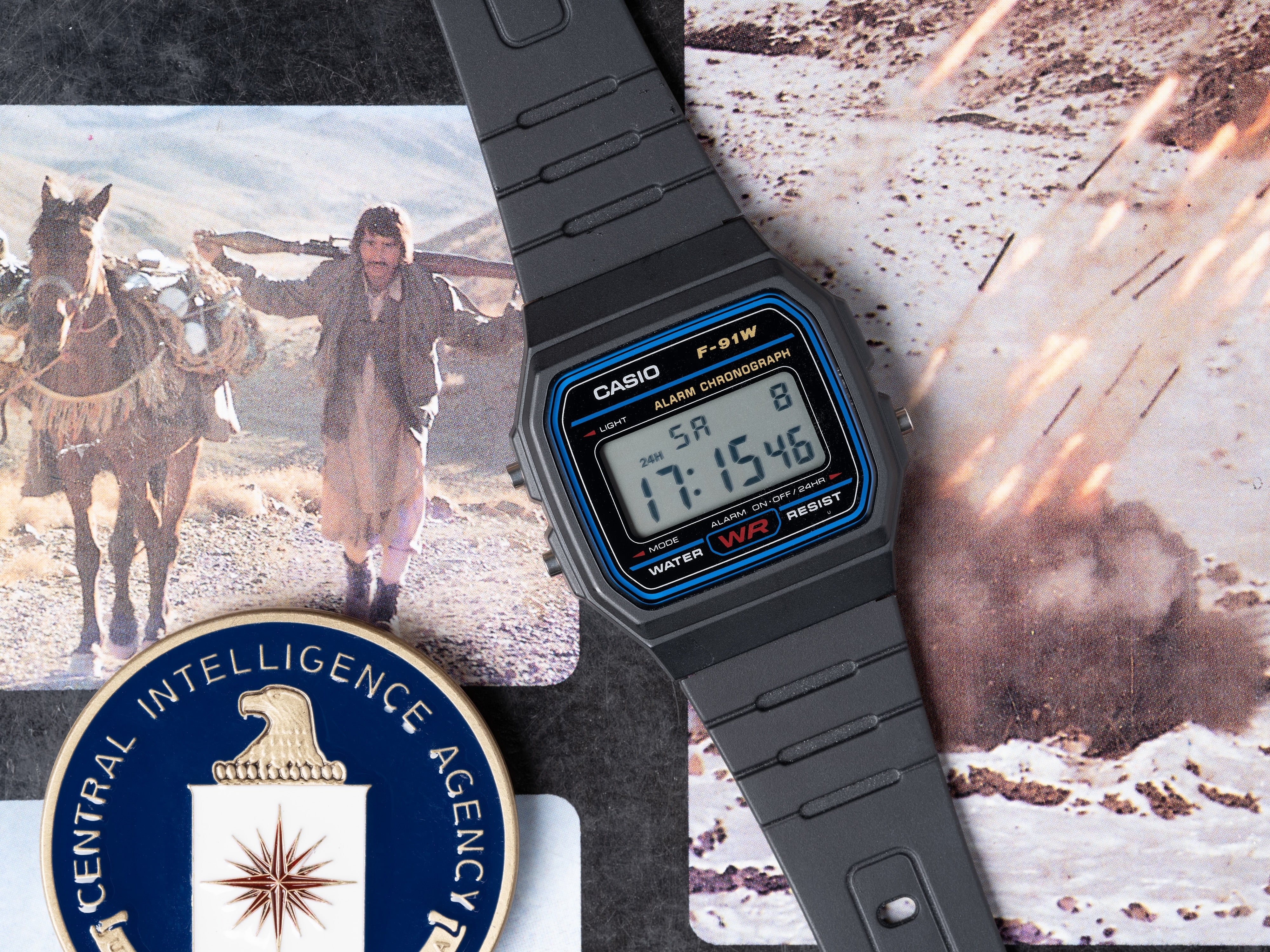
Casio F-91W, the Preferred Watch of Terrorists
The Casio F-91W’s reputation looms large in both horology and national security circles, and for good reason. The simple, cheap and effective plastic watch is...
Read OnThe Casio F-91W’s reputation looms large in both horology and national security circles, and for good reason. The simple, cheap and effective plastic watch is likely one of the most ubiquitous timepieces on the planet, with an estimated three million produced each year since sometime in the early 1990s. However, the watch that is coveted by hipsters and former presidents alike has a more sinister utility: it has been used to deadly effect as a timer for explosive charges and Improvised Explosive Devices (IEDs) and worn regularly by members of al-Qaeda, ISIS and other transnational militant groups.
Read On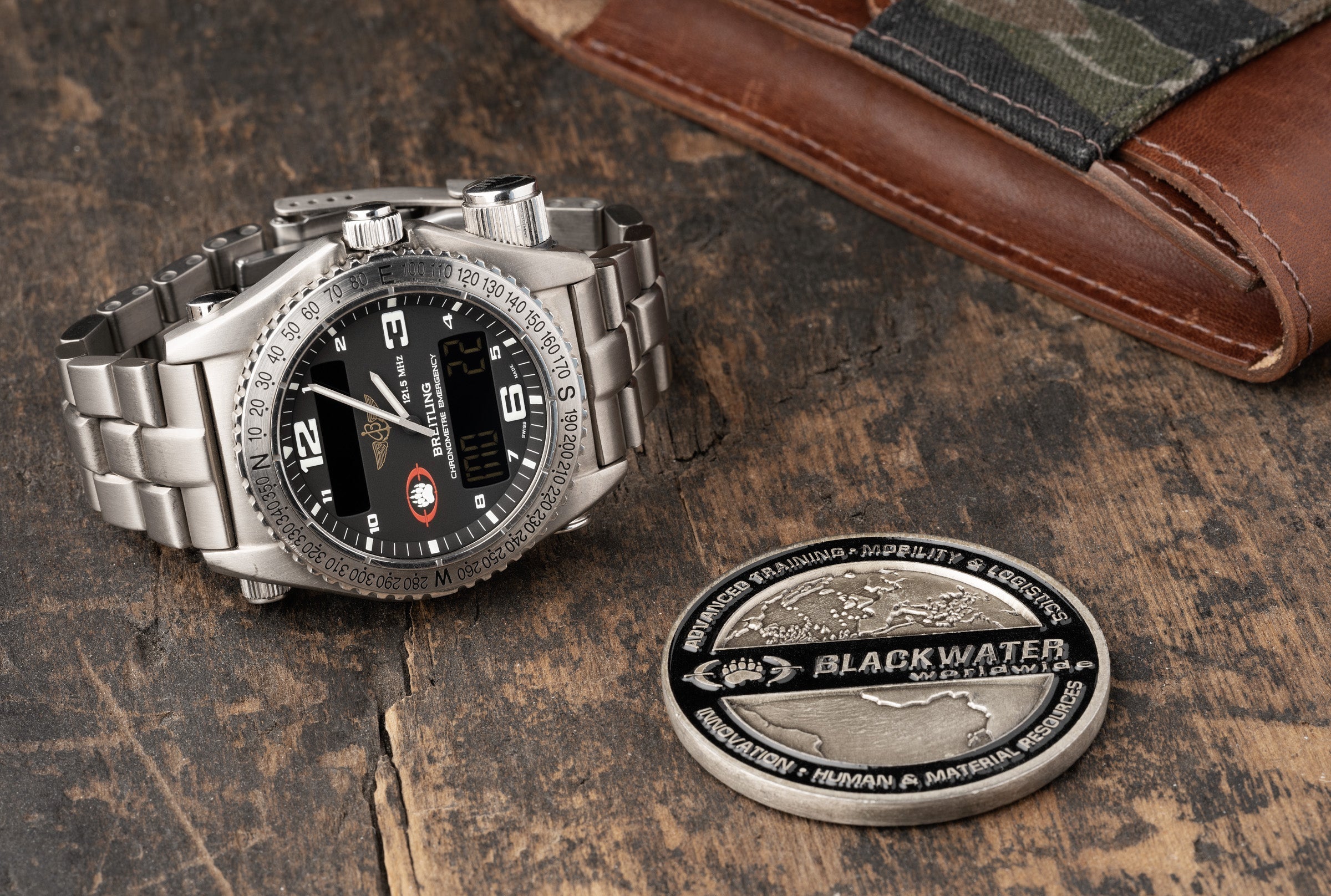
Blackwater Breitling - The Story
Blackwater Breitling: Regardless of one's personal views on Blackwater and their impact on global events, one cannot properly recount the history of modern Intelligence and Special...
Read OnBlackwater Breitling: Regardless of one's personal views on Blackwater and their impact on global events, one cannot properly recount the history of modern Intelligence and Special Operations without discussing Blackwater. In the niche genre of military timepieces and Watches of Espionage this is an important story. Breitling developed this tool watch in the early 1990’s initially focused on the military and the aviation sectors. It was a practical wrist instrument designed for a singular purpose, to locate and rescue those in need.
Read On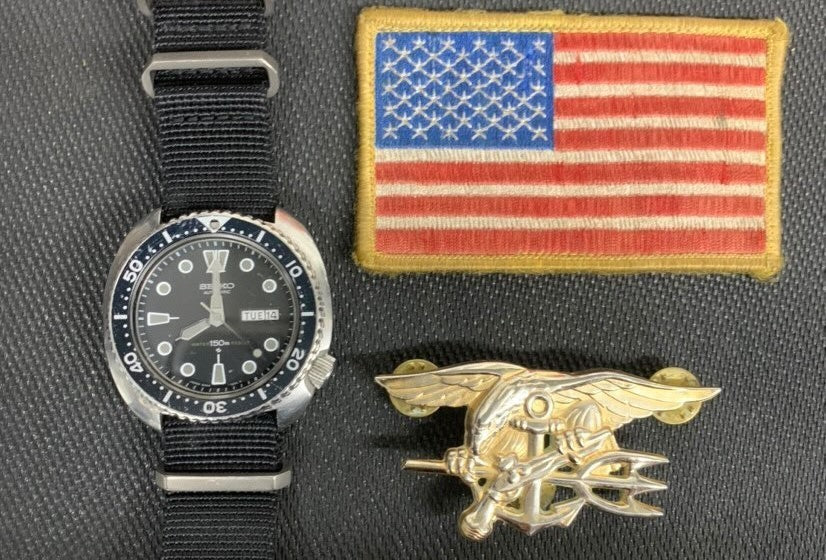
SEAL Team Six and a U.S. Navy-Issued Seiko Turtle
SEAL Team Six and a U.S. Navy-Issued Seiko Turtle For this edition of the W.O.E. Dispatch, we spoke with Kyle Defoor, a former Navy SEAL...
Read OnSEAL Team Six and a U.S. Navy-Issued Seiko Turtle For this edition of the W.O.E. Dispatch, we spoke with Kyle Defoor, a former Navy SEAL Special Mission Unit combat veteran, about his U.S. Navy-Issued Seiko 6309-7049. Kyle Defoor’s Seiko on a Prometheus Design Werx Ti-Ring Strap along with his SEAL Trident, Red Squadron and American Flag patches he wore in Afghanistan. Kyle Defoor has devoted the past 30 years to mastering his craft as a Navy SEAL sniper and decorated combat veteran. He understands the value of practical tools. Clothing, gear, guns and motorcycles are carefully assessed for specific utility and tossed out if they don’t meet the ever-increasing standards. Naturally, Defoor has several watches in his toolkit; but one stands out–a late 1970s U.S. Navy-issued Seiko 6309-7049. In the world of “Watches of Espionage”, this watch has it all: documented provenance connected to two well-known SEALs, operational use on multiple continents, and a story about passing down a watch from father to son. Originally the Seiko was issued to revered SEAL Rudy Boesch in the late 1970s, and then Defoor acquired it in 1996 when his father purchased the watch at an auction supporting the UDT-SEAL Association and gave it to him. He wore the watch in training and operational deployments, including the early years of the war in Afghanistan. The watch wears the scars collected over 40 years of hard use. And to this day, Defoor still wears it as he trains the next generation in firearms and tactics as founder of Defoor Proformance Shooting. Defoor’s Seiko 6309-7049 Seiko watches have a long history with the Special Operations community, specifically their dive watches, which were favored by members of Naval Special Warfare units. While Tudor Submariners were common during the Vietnam War and issued by some Teams into the 1980s, Seiko Divers were standard issue for the SEALs from the 1970s until the mid-1990s, when they were replaced by digital G-Shocks. Nicknamed the “Turtle” due to the recognizable shape of the case, the watch is purely designed with utility in mind. For example, the recessed screw down crown at 4 o’clock works with bulky dive suits and– as Defoor notes– while doing pushups. It’s rated for 150 meters, and that’s good enough for a SEAL, and so is the Caliber 6300 inside. The Turtle was a logical choice for Frogmen in the late 1970s. Defoor's Seiko 6309-7049 Defoor’s reference has what’s known as a “Suwa dial,” and it’s prized by collectors. Suwa dial Turtles were produced from 1976 until circa 1981, and features an “S” above the 6 o’clock marker and the “Japan 6309-704L T” on the bottom of the dial. At 45mm wide and 13mm thick, it is a large watch but wears comfortably due to the short lugs. The day and date complication along with the bi-directional 60-click bezel makes this a practical tool watch fit for rugged use. An automatic movement negates the risk of battery failure, a constant concern for SpecOps. Kyle Defoor Defoor, a sniper and decorated combat veteran, spent 10 years in the Navy SEALs including deployments with SEAL Team 6, 2 and 8. Deciphering the details of Defoor’s career can be difficult because he rarely goes into detail publicly on his service and instead uses vague descriptions of his work like “a trip to Afghanistan” to describe his involvement in some of the most pivotal operations in the early years of that conflict, or “some time in Bosnia” for hunting Balkan war criminals in the 1990s. A self-described “redneck from Alabama,” Defoor has the confidence to be expected of someone with his background, but the rare quality of genuine humility. Defoor enlisted in the Navy when he was 18 years old and after completing BUD/S and earning his Trident, he was assigned to SEAL Team 8. Defoor’s first exposure to real world operations occurred when he deployed to Bosnia to hunt Persons Indicted for War Crimes (PIFWIC) for their actions during the Yugoslav Wars. In July 1996, Defoor attended the Navy SEAL reunion in Little Creek, Virginia, which included a fundraiser for the UDT-SEAL Association. One of the items auctioned to support the association was former Master Chief Petty Officer’s Rudy Boesch’s issued Seiko Diver, ref. 6309-7049. Kyle’s father, fresh off a successful gambling trip in Tunica, Mississippi, was visiting Defoor and also attended the reunion. Flush with cash from the blackjack table, he was eager to purchase an early birthday gift for his son-turned-Frogman and outbid other former SEALs and UDT for the Seiko. Defoor estimates his father paid $500 for the watch, which was a sizable amount from Defoor’s perspective at the time. This was a meaningful gift for a host of reasons, but especially because of the value the Special Operations community places on honoring those who came before us. Tradition and heritage matter. Defoor noted that many of his BUD/S classmates purchased Rolex Submariners to commemorate their graduation, but his humble background meant that he wasn’t able to purchase such an expensive watch. Receiving the Seiko was a memorable moment for Defoor – not only was it a gift from his father, but it came with important provenance. In the mid-1990s, Boesch was a legendary figure in the Naval Special Warfare community, and years later became well-known to the general public due to his participation in the reality show Survivor. Defoor and Boesch in 2013. For years, Defoor asked Boesch for a picture with the watch, joking that a documented picture would allow him to sell it for auction down the road. In what became a running joke, for years Boesch would rebuff Defoor’s attempts and offer a beer instead. In 2013, Boesch finally relented and took the picture with Defoor at a Navy SEAL reunion. Rudy Boesch enlisted in the Navy at 17 years old and had a 45 year career in Naval Special Warfare, making him the longest serving SEAL at the time. He was originally an Underwater Demolition Team (UDT) Frogman prior to joining the newly-formed Navy SEALs in 1962. Boesch earned a Bronze Star for his actions during two combat deployments in Vietnam with SEAL Team 2. After Vietnam, Boesch returned to Little Creek, VA with SEAL Team 2 and it was there that he was issued this Seiko in 1979. Boesch told Defoor that he wore the Seiko until his retirement, but was not a huge fan of the watch as he found it too clunky. After his retirement in 1990, the tool was put unceremoniously in a drawer until the UDT/SEAL Association asked him to donate an item for the 1996 auction. Rudy Boesch in Vietnam as a member of SEAL Team 2 in 1968 After receiving the Seiko, Defoor serviced it at a local Virginia Beach jeweler and wore the watch during Sniper School, then took it on additional deployments to the Balkans where he conducted recce operations in support of the hunt for PIFWCs. At the time, the Navy had transitioned from automatic Seikos to issuing digital G-Shocks, but Defoor stuck with the Seiko. In 2000, he screened for Navy Special Warfare Development Group (SEAL Team Six), which put him in a unique position as a member of the now-famed Red Squadron. That was in September of 2001. When Defoor deployed to Afghanistan shortly after September 11th as an assaulter and recce sniper, the Seiko came with him. Defoor earned the Bronze Star with Valor for actions in Operation Anaconda, a March 2002 battle in the Shahi-Kot Valley targeting al-Qaeda and Taliban forces. Defoor conceded that while the watch was a constant companion during training cycles and deployments, there were times that he used a G-Shock when he knew exact timing was mission essential. He knew the Seiko’s bidirectional bezel was a liability when diving as a knock and resulting accidental advancement could cause a SEAL to overestimate the time he had left underwater. Ironically, in the early 2000s, SEALS found themselves spending more time in the mountains and deserts of Afghanistan than underwater. Defoor in Afghanistan in early 2002 While Defoor’s career is notable by any standard, his legacy will likely be in the training realm. After leaving the military, he founded “Defoor Proformance Shooting,” and has devoted his life to preparing the next generation of warriors and developing tools for those on the front lines. Defoor is a leader in the firearms and tactics space and trains thousands of students each year from the U.S. military, law enforcement and government agencies, and is also involved with product development as a consultant for Tenicor, Bravo Company USA, Staccato Firearms and Vortex Optics. In addition to operational deployments, the watch has been a constant presence in Defoor’s life and a conscious choice for more personal, but no less important, events. It was on his wrist as he rode his motorcycle across the country, walked his daughter down the aisle to hand her off to another SEAL and in the delivery room for the birth of his son. Preparing to one day hand the watch down to his son, Defoor recently purchased a Sangin Neptune. Kyle, thank you for sharing your story with W.O.E and for everything you have done and continue to do for our community. Read Next: The Pragmatic Journey Of A SEAL Through Watch Collecting
Read On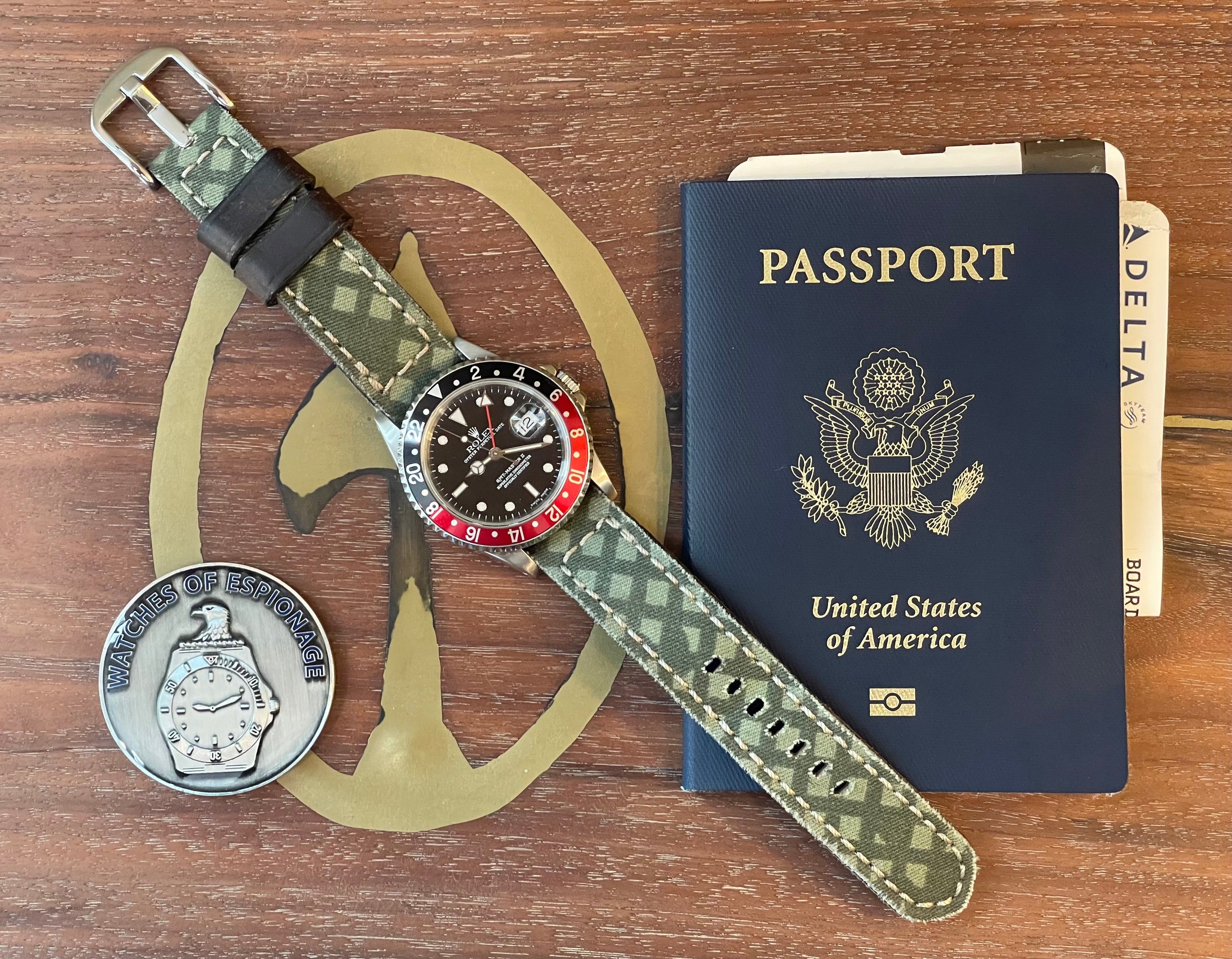
Criminal Rolex Gangs and Traveling with Watches, Part I
In this week's Dispatch, we explore the massive uptick in watch-related crime and offer some tips on how to safely use your tools while traveling....
Read OnIn this week's Dispatch, we explore the massive uptick in watch-related crime and offer some tips on how to safely use your tools while traveling. The Risks of Traveling With A Luxury Watch in 2022.
Read On